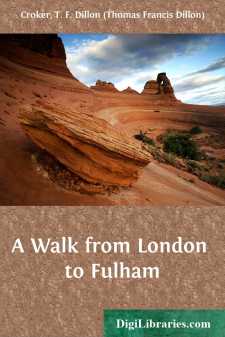Categories
- Antiques & Collectibles 13
- Architecture 36
- Art 48
- Bibles 22
- Biography & Autobiography 813
- Body, Mind & Spirit 142
- Business & Economics 28
- Children's Books 15
- Children's Fiction 12
- Computers 4
- Cooking 94
- Crafts & Hobbies 4
- Drama 346
- Education 46
- Family & Relationships 57
- Fiction 11829
- Games 19
- Gardening 17
- Health & Fitness 34
- History 1377
- House & Home 1
- Humor 147
- Juvenile Fiction 1873
- Juvenile Nonfiction 202
- Language Arts & Disciplines 88
- Law 16
- Literary Collections 686
- Literary Criticism 179
- Mathematics 13
- Medical 41
- Music 40
- Nature 179
- Non-Classifiable 1768
- Performing Arts 7
- Periodicals 1453
- Philosophy 64
- Photography 2
- Poetry 896
- Political Science 203
- Psychology 42
- Reference 154
- Religion 513
- Science 126
- Self-Help 84
- Social Science 81
- Sports & Recreation 34
- Study Aids 3
- Technology & Engineering 59
- Transportation 23
- Travel 463
- True Crime 29
A Walk from London to Fulham
Description:
Excerpt
The late eminent genealogist, Sir W. Betham of Dublin, Ulster King-at-Arms, well known as the author of numerous works on the Antiquities of Ireland, and Mr. Richard Sainthill, an equally zealous antiquary still living in Cork, were two of the most intimate friends and correspondents of the late Mr. Crofton Croker.
The first-named gentleman drew up an elaborate table tracing the Croker pedigree as far back as the battle of Agincourt. The Croker crest—“Deus alit eos”—was granted to Sir John Croker, who accompanied Edward IV. on his expedition to France in 1475, as cup and standard-bearer; but without going back to the original generation, or tracing the Limerick or any other branch of the family, it will be sufficient to say here that the Crokers, if they did not “come over with William the Conqueror” came originally from Devonshire, and settled in Ireland in the reign of Elizabeth. Thomas Crofton Croker was the only son of Thomas Croker, who, after twenty-five years of arduous and faithful military service in North America, Holland, and Ireland, and after having purchased every step in the army, was gazetted brevet-major on the 11th May, 1802, in the same regiment which he had at first joined (the 38th, or 1st Staffordshire Foot), and in which he had uninterruptedly served. Indeed, he was so much attached to his regiment, that, in his case at least, the Staffordshire knot became perfectly symbolic. The closer the knot was drawn the firmer the tie became. He commenced, continued, and ended an honourable life of activity in the service of his country from mere boyhood, until ill-health and a broken constitution forced him to sell his commission. Thomas Croker was the eldest son of Richard Croker, of Mount Long in the county of Tipperary, who died on the 1st January, 1771; and his mother was Anne, the daughter of James Long of Dublin, by the Honourable Mary Butler, daughter of Theobald the seventh Earl of Cahir. Thomas Croker was born on the 29th March, 1761. In 1796 he married Maria, eldest daughter and co-heir of Croker Dillon of Baltidaniel in the county of Cork, and on the 15th January, 1798, Thomas Crofton Croker was born at the house of his maternal grandmother in Buckingham Square, Cork, receiving his first Christian name after his father, and his second after his godfather, the Honourable Sir E. Crofton, Bart.
While very young, during the years 1812 and 1815, Crofton Croker made several excursions in the south of Ireland, studying the character and traditions of the country, on which occasions he was frequently accompanied by Mr. Joseph Humphreys, a Quaker, afterwards master of the Deaf and Dumb Institution at Claremont near Dublin. In 1813 he was placed with the mercantile firm of Messrs. Lecky and Mark, and in 1817 he appeared as an exhibitor in the second exhibition of the Cork Society, for he had already displayed considerable talent as an artist. In 1818 he contributed to an ephemeral production called ‘The Literary and Political Examiner:’ on the 22nd March of that year his father died, and he left Ireland, not to revisit it until he made a short excursion there in 1821 with Alfred Nicholson and Miss Nicholson (who afterwards became Mrs. Croker), children of the late Mr. Francis Nicholson, one of the founders of the English water-colour school, and who died in 1844 at the patriarchal age of ninety-one years.
Crofton Croker’s first visit to England was paid to Thomas Moore in Wiltshire; and soon after his establishing in London he received from the late Right Hon....


